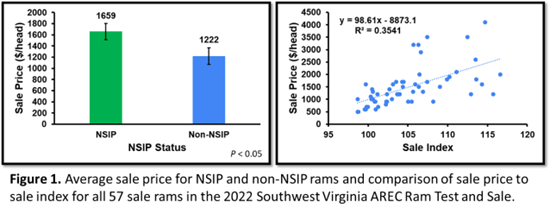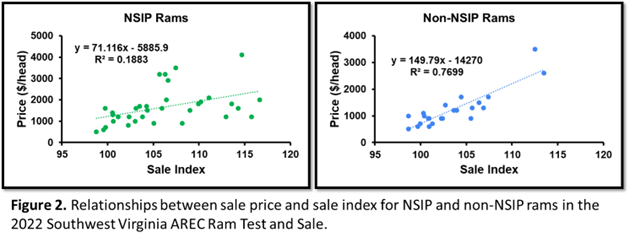In 2022, the Southwest Virginia Agricultural Research and Extension Center hosted its 10th ram test and sale. Over the years, the program has developed a strong reputation for the development and identification of superior rams for growth and parasite resistance in a forage-based environment. Historically, the test has included rams from NSIP flocks and some rams from flocks not enrolled in NSIP (non-NSIP). The 2022 test and sale data were analyzed to explore the impact of NSIP enrollment on ram performance and value in the program.
The 2022 test included 119 rams from 10 states. Rams were delivered in late May and the test began June 22. Fecal egg counts, FAMACHA scores and weights were collected every other week until late August. Rams were ranked based on a sale index (see below) that equally weights growth performance (test average daily gain ratio and weight per day of age ratio) with parasite resistance measured by fecal egg count. Rams with higher sale indexes had greater growth and improved parasite resistance relative to their contemporaries on test. This index was not meant to be a selection index. It was simply a way to determine sale qualifying rams and a sale order. The top half of rams were selected for the sale held in late September.
Sale Index =
1/2 X (1/3 X Average Daily Gain Ratio + 2/3 X Weight per Day of Age Ratio) + 1/2 X logFEC Ratio
On test, 51% of rams were enrolled in NSIP and 49% were not. When the top half of the rams were identified (Sale Index ≥ 100), 60% of the rams were in NSIP and 40% were not. When the top 20% of rams were evaluated, 78% were NSIP rams. 57 rams (34 NSIP and 23 non-NSIP) were sold averaging $1482. The NSIP rams commanded an additional $437 compared to non-NSIP rams (Figure 1). This led to the question, “How well did the sale index predict sale price?” The sale index did alright at explaining 35% of the variation in sale price (Figure 1). But did it do a better job for NSIP rams or non-NSIP rams?

This comparison is illustrated in Figure 2. The sale index explained 19% of the variation in sale price for NSIP rams while it explained 77% of the variation in sale price for non-NSIP rams. The index did a much better job predicting value for the rams not enrolled in NSIP. Why? NSIP rams have much more data to offer compared to non-NSIP rams. These data are estimated breeding values (EBVs). These EBVs are superior selection tools offering far more accuracy for decision-making. The only data associated with non-NSIP rams are test performance metrics (i.e. sale index). Thus, when making purchasing decisions, NSIP ram buyers have a lot more to consider when determining ram value and overall, value these rams more than non-NSIP rams. Non-NSIP ram buyers base their price determination largely on test performance. Ram tests offer valuable data for both groups. These data help validate EBVs for NSIP rams while providing sought-after, value-determining performance data for non-NSIP rams. We hope you can join us for the 2023 Southwest Virginia AREC Ram Test!

By: Dr. Andrew Weaver, NCSU Small Ruminant Specialist
![]()


